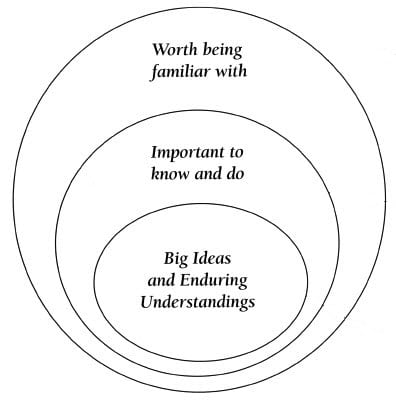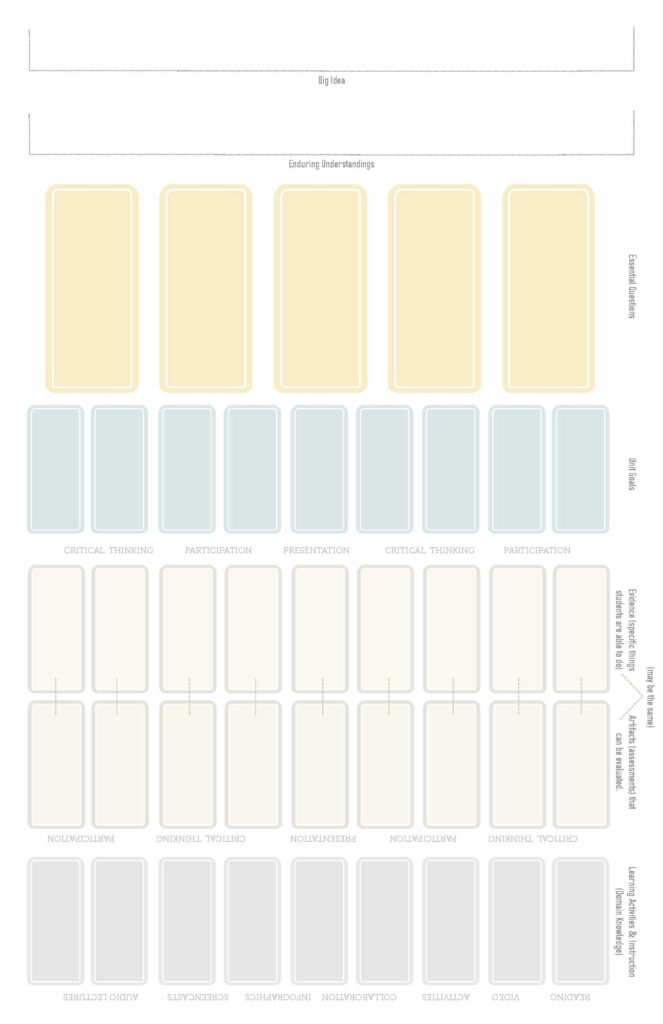Enduring Understandings
The learning that will stay with you.
What are Enduring Understandings?
Enduring Understandings are the insights that a learner gains by doing the work of understanding, i.e. making connections in our learning that help us make sense of and integrate new knowledge into existing understandings. In the Understanding by Design framework, the Big Idea can be thought of as the point on the horizon you are steering towards, Essential Questions can be thought of as the locomotive pulling your students forward (an engine of inquiry) and Enduring Understandings can be thought of as the sights and memories one remembers when looking back. Enduring understandings summarize important ideas and core processes that are central to a discipline and have lasting value beyond the classroom. They synthesize what students should understand–not just know or do–as a result of studying a particular content area. Moreover, they articulate what students should “revisit” over the course of their lifetimes in relationship to the content area (Wiggins and McTighe, 2003).
Enduring understandings:
- Frame the big ideas that give meaning and lasting importance to such discrete curriculum elements as facts and skills;
- Can transfer to other fields as well as beyond the classroom;
- “Unpack” areas of the curriculum where students may struggle to gain understanding or demonstrate misunderstandings and misconceptions;
- Provide a conceptual foundation for studying the content area and;
- Are deliberately framed as declarative sentences that present major curriculum generalizations and recurrent ideas.

How Can I Use Enduring Understandings in My Course?
Enduring Understandings, along with Big Ideas and Essential Questions, guide a Backward Design process by framing the first stage: Identifying desired results. You can use Enduring Understandings in in planning your course as a way to help identify what you expect students to get out of the course and how those “results” will be distributed between assignments and scaffolded through course content. Identifying your Enduring Understandings will help you clarify and prioritize your course design.
Enduring Understandings should be stated as full sentences. What are the broad understandings that connect the content in your course? What should students come away understanding about the topic of your course? These might not be ideas that you study directly, but they likely do come up repeatedly through the semester and underly a number of the decisions about what to include vis-a-vis content. These understandings are not facts but inferences, so it may help to state them as a proposition or maxim.
Examples:
1. There were several significant and interrelated causes of the American Civil War, including the morality of slavery, different views of the role of the federal government, and differing regional economies.
2. Writing is a series of choices — choices in language, grammar, organization, and reference.

Considerations for Online Courses
Enduring Understandings are often the sorts of ideas that come up with students in discussion in a face-to-face course — a student hints toward an understanding connecting content and you help highlight and articulate that for the rest of class. You use lecture and discussion to drive this understanding home, bringing it up again and again, noting it every time it arises related to the topics you are covering. What to do in an online course, where these often spontaneous opportunities for emphasizing the understandings arising out of content seem less available?
Depending on the structure of your course, there are many opportunities to integrate Enduring Understandings across activities and content. If you have a discussion forum and you notice a few students connecting to one of your articulated understandings, point that out in the forum and also consider writing a follow-up announcement that is distributed to the entire class, highlighting the pieces of the discussion that led to the understanding. One of the great advantages of teaching online and designing your course in advance of delivery is that you have time during the semester to focus on giving feedback and connecting 1-1 with students. When you are assessing and commenting on student work, try to help them see how their ideas and proposals are relating to the understandings and big ideas you are driving toward in your course.
Don’t forget that students may be developing their own understandings based on your course content and teaching. What could you learn from your students? How might you put your aimed-for enduring understandings in conversation with those that the students may be leaving the course with?
Research Foundations
Haddad, A. (2005). Teaching for Enduring Understandings in Ethics. Journal of Physical Therapy Education, 19 (3).
Stewart, M. G. (2014). Enduring understandings, artistic processes, and the new visual arts standards: A close-up consideration for curriculum planning (PDF).. Art Education, 67 (5), 6-11.
Wiggins, G., & McTighe, J. (2005). Understanding by Design (2nd ed.). Alexandria, VA: Association for Supervision and Curriculum Development.
Watch:
UAF CTL’s Associate Director of Programs, Owen Guthrie, sheds some light on the concept of “Enduring Understandings”.
Enduring Understandings: Further Resources

UAF Instructional Designers
This page has been authored collectively by the experts on the
UAF Instructional Design Team.
Let us know if you have suggestions or corrections!
